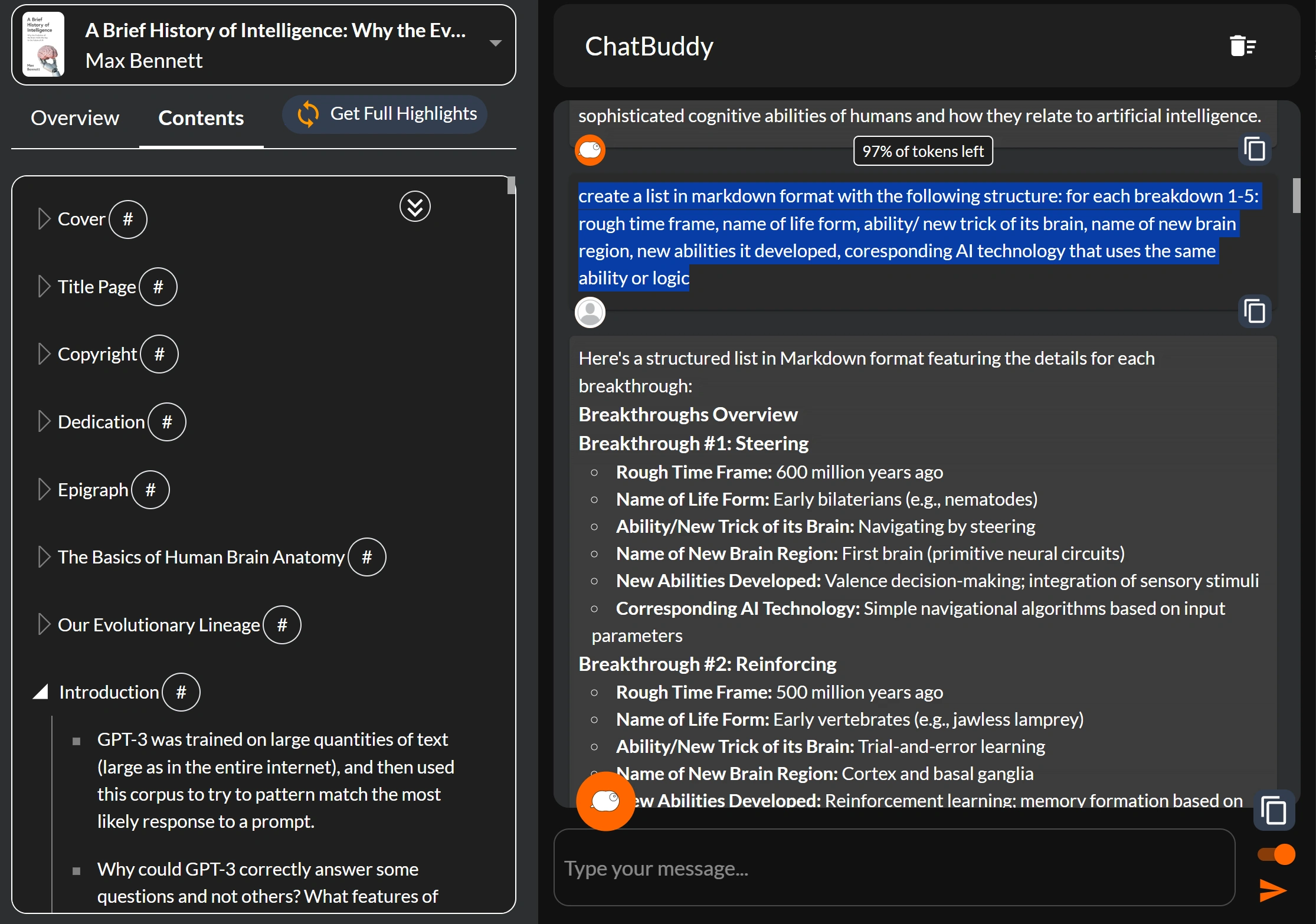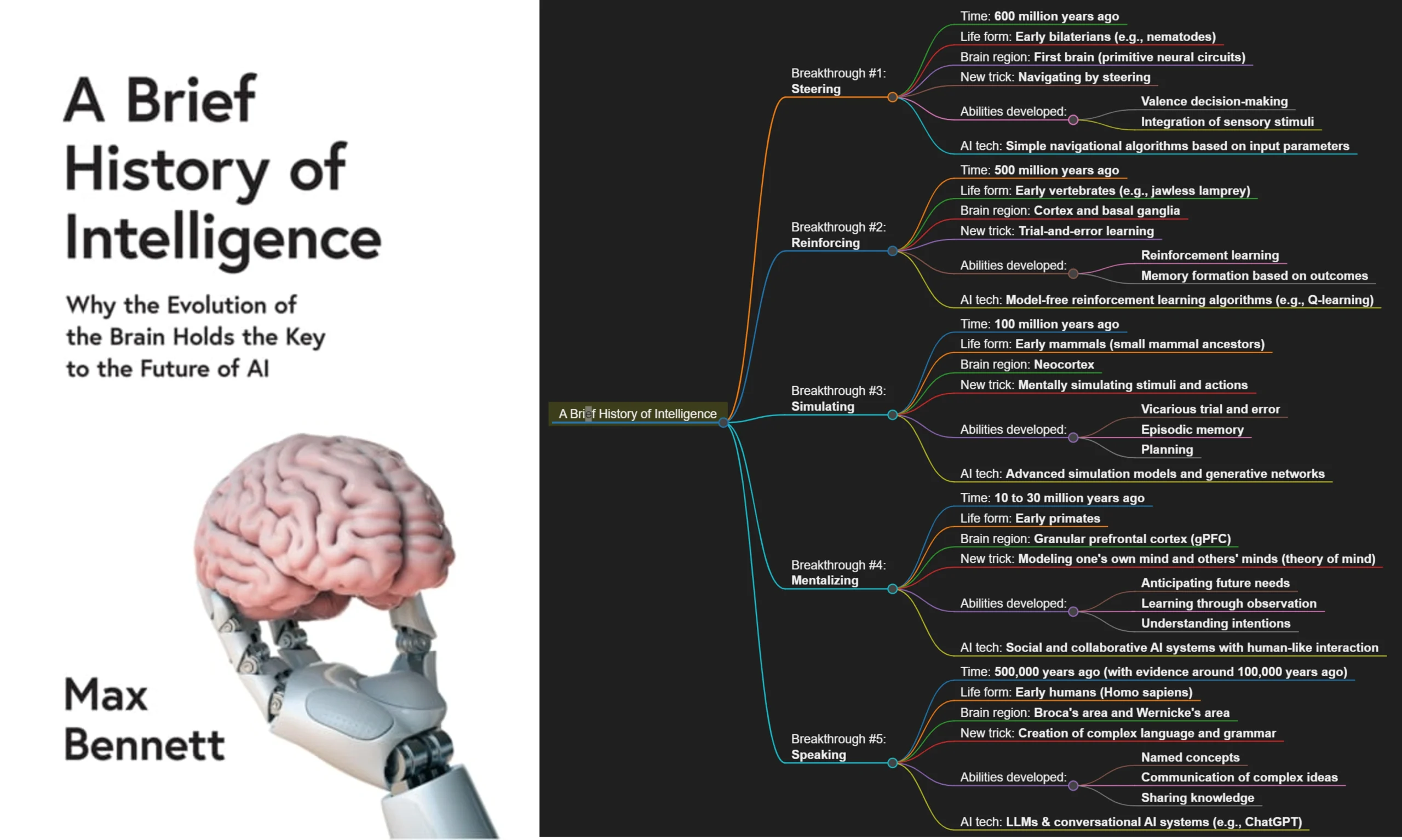Why This Book Matters
I've long wanted to understand the human brain at a fundamental level—how it differs from simpler life forms, the functions of various brain regions, and how this relates to current AI capabilities. Bennett's book delivers this knowledge in a remarkably concise, well-structured way.
But rather than simply finishing the book and moving on, I wanted to ensure this knowledge becomes permanently accessible to me. This is where externalized knowledge creation becomes crucial.
Remember: Reading + Externalized Knowledge + Deliberate Practice = Lasting Understanding
Before jumping to your next book, investing a fraction of the time you spent reading to create externalized knowledge yields enormous returns. This small additional effort transforms fleeting information into accessible wisdom that you can recall precisely when you need it—during an exam, in the middle of a discussion, or while presenting to others.
My Process for Creating a Mind Map with DeepRead
Think of yourself as an explorer venturing across uncharted territory. Your mind map serves as a carefully crafted cartographic guide, containing the essential landmarks needed for your intellectual journey through a book's terrain. Whenever you find yourself disoriented by intricate details, you can unfold this map to regain your bearings and perspective. As your understanding deepens, you can enrich the map with new discoveries and insights along the way. Even years after your expedition, you can revisit this personal atlas to quickly survey the book's intellectual landscape. With time, you may find yourself able to mentally visualize the entire topography—perceiving pathways and connection points without physically consulting the map. This is the true power of a mind map: a navigator's companion for your intellectual explorations.
Bennett's book is ideally structured for knowledge mapping, as it revolves around five evolutionary breakthroughs in brain development. For each breakthrough, Bennett explains how early life forms used their nervous systems to navigate specific environments, which brain regions were present, what new abilities emerged, and even how these relate to current AI technologies.

Here's how I approached creating my externalized knowledge structure:
- Identify the book's natural organization: The book clearly revolves around five evolutionary breakthroughs, making this the natural framework for my mind map.
- Determine the key information categories: For each breakthrough, I wanted to capture:
- Approximate time frame
- Name of the life form
- New brain capabilities
- Name of the new brain region
- Resulting abilities
- Corresponding AI technologies using similar principles
- Use DeepRead's chat functionality: I prompted the system to create a structured list in markdown format containing these elements.
- Refine the output: I improved language, verified accuracy against my highlights, and ensured the format worked well with DeepRead's mind map feature.
The resulting mind map gives me a hierarchical view of 4.5 billion years of brain evolution, from the simplest stimulus-response mechanisms to human consciousness—all visible at a glance.
Why Mind Maps Are Worth Your Time
A well-crafted mind map serves multiple purposes:
- Reorientation tool: When you get lost in details, the mind map helps you regain perspective on how everything fits together.
- Expandable framework: You can add more detail to specific branches as you encounter new information.
- Long-term reference: Years after reading, you can quickly refresh your understanding of the book's core concepts.
- Mental simulation aid: Eventually, you may be able to recall the map structure mentally, allowing you to navigate the concepts without referring to the physical map.
Every book that offers substantial new knowledge deserves this kind of transformation. For structured books like Bennett's, creating such a map is relatively straightforward—especially if you've taken highlights while reading. DeepRead significantly streamlines this process by organizing your highlights by chapter and enabling AI-assisted knowledge structuring.
From Passive Reading to Knowledge Creation
The small investment in creating externalized knowledge transforms you from a passive consumer of information into an active creator of personal knowledge assets. Your future self will thank you when these well-structured ideas are readily available precisely when you need them most.
Instead of vaguely remembering "that book about brain evolution and AI," you'll have a rich, hierarchical understanding ready to deploy in conversations, writing, or problem-solving.
So the next time you finish a valuable book, don't immediately reach for the next one. Take a moment to create your map—your mental anchors—and secure what you've learned for the long term.
